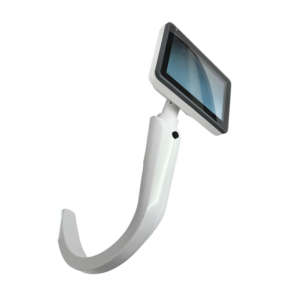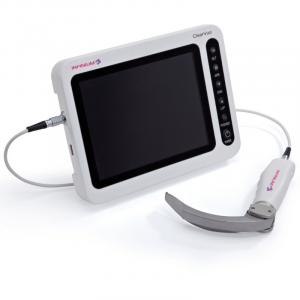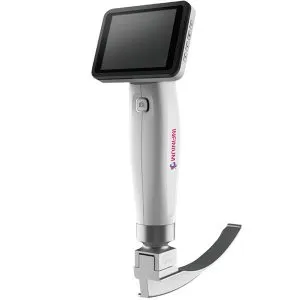Healthcare facility directors know the importance of having cutting-edge equipment for their providers. Video laryngoscopes offer a new alternative for airway intubation. This tool also has many therapeutic advantages during neck and head procedures.
This tool gives medical providers a clear, unobstructed view of the mouth and throat. This allows them to quickly treat and diagnose patient conditions. Keep reading to learn more about video laryngoscopes.

Types of Laryngoscopes
Providers use laryngoscopes to perform several different procedures. This tool allows the physician to examine different parts of the throat using various laryngeal views. This includes the back of the throat, larynx (voice box), and vocal cords.
There are several different approaches to performing this procedure. The following gives a brief overview.
Indirect Laryngoscopy
The indirect method involves the use of a mirror and light to view the throat area. Some physicians wear headgear with a light mounted on it to free up their hands.
Providers may do this in their office after numbing the back of the throat. This approach isn’t used as often since the introduction of the flexible laryngoscope.
Nasolaryngoscopy
A fiberoptic laryngoscope is a small, flexible telescopic instrument. The provider slides this through the nose and down into the throat. This approach is often used to examine the larynx and takes less than one minute.
Direct Laryngoscopy
A flexible or stiff laryngoscope is inserted into the back of the throat. Most patients receive anesthesia for this procedure.
Video Laryngoscopy
The newest instrument on the market is the video laryngoscope. Unlike other similar procedures, this approach includes a video screen.
Reasons for Performing a Laryngoscopy
This procedure is now performed for a wide variety of reasons. It’s used during surgery to keep the airway open after sedating the patient.
This is commonly called intubation. Intubation is also used to provide respiratory support with a mechanical ventilator.
Another key reason for performing a laryngoscopy is to remove foreign objects. Patients also undergo this procedure to diagnose ongoing problems. Examples include the following.
- Difficulty speaking, swallowing, or breathing
- Ongoing cough, throat pain, bloody cough, or bad breath
- Prolonged hoarseness, laryngitis, breathy, or weak voice
- Ongoing earaches
- Examination of a mass detected in the throat
- Removal of throat polyps
This procedure is also used to look for injuries, narrowing, or blockages of the throat. The provider can take tissue samples (biopsies) and perform laser treatments as well.
Possible Risks Associated with Laryngoscopy
The success of any laryngoscopy depends on the provider’s experience and the device. It’s key to choose the correct blade for the patient’s mouth and throat size. Users must also properly shape the endotracheal tube when intubating.
While laryngoscopy is considered safe, risks may arise. It’s important for the provider to demonstrate proficiency before performing this procedure.
During video laryngoscopy, providers should develop a habit of changing their focus. Alternate between looking at the screen and in the mouth. This decreases the risk of complications associated with trauma.
Different laryngoscopic procedures carry specific risks for complication. A general overview of potential adverse events includes:
- Allergic reactions to the medications used for anesthesia
- Heart problems
- Difficulty breathing caused by vocal cord spasms
- Infection
- Bleeding (minor to major) in the throat
- Blood clots
- Mouth and/or throat ulcers
- Nosebleeds, especially with nasolaryngoscopy
- Oropharyngeal trauma to the tongue, lips, or teeth
- Hoarseness
- Sore throat or mouth pain
- Vomiting or gagging
Patients who smoke may have an increased risk of complications. The physician or nurse will provide specific instructions for after-care. If the patient experiences any of these problems, they should call their provider.
The Infinium ClearVue™ Video Laryngoscope Screen Visualization
The Infinium ClearVue™ is a state-of-the-art video laryngoscope. It provides the clearest view of the throat, larynx, and vocal cords. The customized hand-eye coordination features also promote high-level performance.
This makes treatment, biopsies, intubation, and diagnosis easier. It has a 3.5-inch display with an optional HDMI output to add a remote display. This makes it a great teaching tool as well.
The anti-shatter-protected screen and rigid steel chassis ensure lasting durability. Providers won’t need to worry about fogging because it has an anti-fog lens.
The quick-shot, 2.0-megapixel camera, makes it easy to record and document the procedure. It includes four gigabytes of data storage which equals about 80 minutes of video. This is essential for future consultation and medical-legal requirements.
This lightweight instrument weighs less than 350 grams. It uses long-lasting rechargeable lithium-ion batteries. Thus, the providers won’t have procedures interrupted by battery failures.
The scope comes with disposable blades and reusable blades. They’re quick and easy to install and remove.
You can use the reusable blades over 1,000 times. This reduces your costs for disposable materials.
The Infinium ClearVue™ Video Laryngoscope comes with Macintosh blades in sizes 2, 3, and 4. You also may order additional blades in sizes 1, 2, 3, 4, and 5.
Infinium offers Macintosh Curved “D” Blades in sizes 1, 2, 3, 4, and 5. You may also purchase the Miller Blades in sizes 0 and 1. This video laryngoscope has a two-year warranty which makes it a smart investment.




